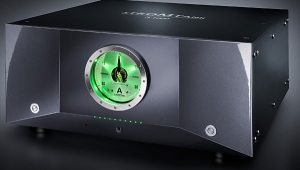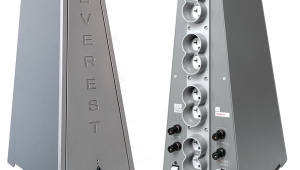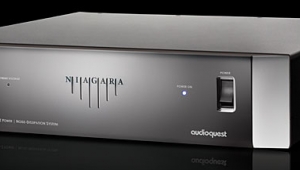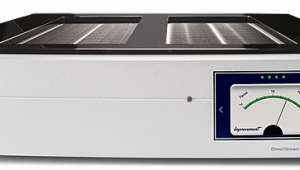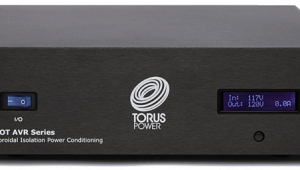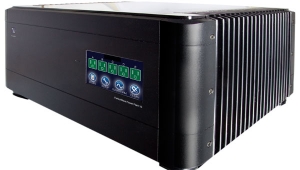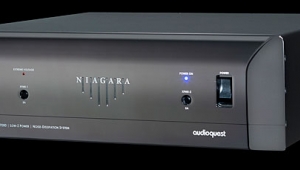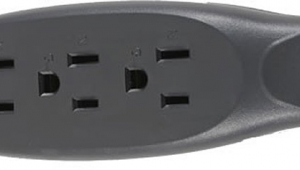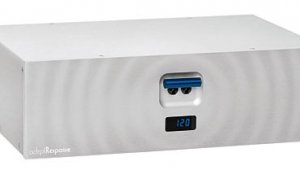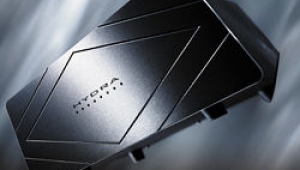| Columns Retired Columns & Blogs |
PS Audio Ultimate Outlet AC conditioner Page 2
Of course, these advantages will exist only if the balun transformer is "well-designed"—and a great deal of work at PS Audio has gone into determining the right size of balun for this application, selection of the appropriate wire (heavy-gauge Litz), making sure the windings around each half of the donut match exactly, and, in general, selecting all components with optimal audio and video quality as criteria. The UO includes protection from power-line spikes and surges, and its ability to clean up AC is said to be bidirectional, so that noise and harmonics generated by equipment plugged into it are not dumped back into the power line, where they are likely to affect other components.
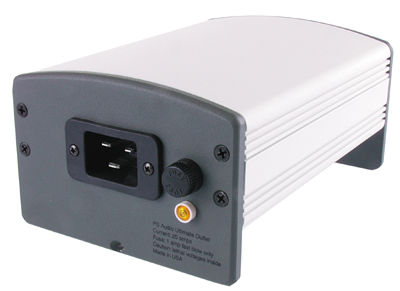
Three versions of the UO are available: Standard (15 amp), High Current with 20-amp IEC connector, and High Current with 15-amp IEC connector. The Standard is recommended for any source or video equipment, as well as small solid-state power amps. The High Current UOs are for tube power amps and solid-state amps rated at more than 100Wpc. The High Current UOs are internally identical, differing only in the type of input connector used. (PS Audio initially produced the High Current model only with the 20-amp IEC plug, but later they decided to offer it with the 15-amp IEC plug so that it can be used with a variety of high-end power cords, which are not normally available with a 20-amp IEC plug.)
The High Current UOs have the same size balun as the Standard, but the parallel wires wrapped around the donut effectively double the thickness of wire used in the Standard version without increasing the inductance. The High Current UOs also feature a special high-quality duplex AC socket called a Power Port, which is also available separately for $49.95, and is recommended by PS Audio as a replacement for all wall sockets used with audio/video equipment. PS Audio provided two samples of the Standard UO and two High Current 20-amp IEC UOs, but the High Current samples were from the first production run, and had normal hospital-grade sockets rather than Power Ports.
Sound
The first question I wanted to answer was whether plugging audio equipment into the UO would result in a significant improvement over the sound I got with the equipment plugged directly into the wall sockets. I normally have my preamp, digital front end, and turntable plugged into a PS Audio P300 Power Plant (MultiWave set at "SS5," indicated voltage reduced to 112V to compensate for the P300's inflated readout at this setting). To refresh my memory of what the system sounded like without benefit of the Power Plant, I plugged the preamp and source components into a PS Audio Juice Bar power strip, and the Juice Bar into the wall socket (hospital grade, dedicated line) via the same PS Audio Lab Cable that had been connected to the P300. The Juice Bar has three Power Ports, but no power-line-conditioning circuitry. I used it because there were not enough conveniently located wall sockets to accommodate the plugs from all the equipment.
Listening to the system with AC coming directly from the wall socket rather than the P300, I was struck by how comparatively lifeless and flat the music sounded. It was almost as if someone had turned down the volume while I wasn't looking—an observation that echoes a comment I made in my original review of the P300. I know that there was no actual change in level; I think the subjective difference in loudness was a function of the difference in noise level, and thus the signal/noise ratio. Dynamics were more restrained and transients lost some of their crispness. The soundstage seemed to shrink in depth, and images within the soundfield became slightly hazy. I venture to say that anyone hearing the system for the first time would still have been impressed—but for me, accustomed as I was to the sound of the system with the P300 in it, going back to untreated AC was a major letdown.
Changing to the Standard UO (Lab Cable from wall socket to UO, Mini Lab Cable from UO to Juice Bar) restored much of the sound quality I'd been used to with the P300 providing the AC. There was a noticeable increase in transient crispness and dynamics, an improvement in the focus of images within the soundstage, and, in general, music became more involving. The sound was not as good as with the MultiWave-equipped P300, but I'd say it was at least halfway to it.
Replacing the Standard UO with the High Current 20-amp IEC version (using the supplied power cable with its 20-amp IEC plug) brought about a further advance in sound quality. Dynamics were improved; the soundstage became deeper, and there was some increase in bass clarity. I found this surprising, in that the current draw of the preamp and source components was well below the Standard UO's 15-amp rating, so there was no reason to believe that the Standard UO's current capability was in any way a limiting factor. Still, the High Current UO sounded better.
Very late in the auditioning process, I received a sample of the High Current 15-amp IEC from current production. This had the new Power Port duplex sockets, and the 15-amp IEC connector allowed me to use the Lab Cable. The High Current UO/Lab Cable combination sounded better still, to the extent that it was very nearly equal to the effect of the P300 in the standard 60Hz position. (The P300 with MultiWaveS5 engaged was still ahead in dynamics.) I do like the more robust 20-amp IEC connector; unfortunately, the Lab Cable and most other high-end power cables come with 15-amp plugs.
- Log in or register to post comments
